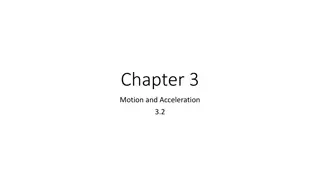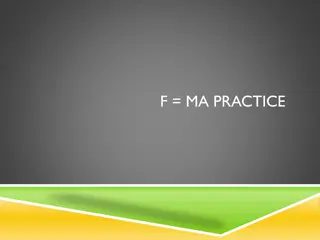Understanding Motion Under Constant Acceleration
Constant acceleration refers to motion where the speed increases by the same amount each second. It is exemplified in scenarios like free fall due to gravity, where objects experience a consistent acceleration of approximately 10 meters per second squared. This type of motion plays a significant role in everyday life, such as when objects are dropped and move downward under the influence of gravity. The equation v = ?i + at represents motion with constant acceleration, showcasing how velocity changes at a constant rate. It is important to understand that constant acceleration is distinct from zero acceleration, as the former involves a consistent change in velocity over time.
Download Presentation

Please find below an Image/Link to download the presentation.
The content on the website is provided AS IS for your information and personal use only. It may not be sold, licensed, or shared on other websites without obtaining consent from the author. Download presentation by click this link. If you encounter any issues during the download, it is possible that the publisher has removed the file from their server.
E N D
Presentation Transcript
MOTION UNDER CONSTANT ACCELERATION
Constant Acceleration Constant acceleration refers to motion where the speed increases by the same amount each second. The most notable and important example is free fall. When an object is thrown or dropped, it experiences a constant acceleration due to gravity, which has a constant value of approximately 10 meters per second squared.
Is constant acceleration 0? Zero acceleration means there is no change in velocity i.e. body is moving with same velocity but constant acceleration means velocity of a body increases or decreases with same rate i.e. by same amount in same time.. so, zero acceleration and constant acceleration are not same
Motion with constant acceleration Motion with constant acceleration occurs in everyday life whenever an object is dropped: the object moves downward with the constant acceleration, under the influence of gravity.
What is the equation for motion with constant acceleration? The equation v = ??- ??reflects the fact that when acceleration is constant, v is just the simple average of the initial and final velocities. The acceleration is constant, with velocity increasing at a constant rate.
What happens at constant acceleration? An accelerating object will change its velocity by the same amount each second. This is referred to as a constant acceleration since the velocity is changing by a constant amount each second. An object with a constant acceleration should not be confused with an object with a constant velocity.
Kinematic equations for one-dimensional motion with constant acceleration Let us consider one-dimensional motion in the x- direction. The average acceleration equals the instantaneous acceleration. From ax= (vxf- vxi)/(tf- ti) we obtain ax(tf- ti) = (vxf- vxi), or vxf= vxi+ ax t. The velocity versus time graph is a straight line.
Average velocity The average velocity in a time interval t therefore is just the sum of the final and the initial velocities divided by 2, vx(avg)= (vxf+ vxi)/2.
Displacement The displacement is x = vx(avg) t. We can rewrite this expression to obtain xf- xi= (vxf+ vxi) t or xf- xi= vxi t + ax t2.
Velocity as a function of the displacement We can also express the velocity as a function of the displacement. x = (vxf+ vxi) t = (vxf+ vxi)(vxf- vxi)/ax = (vxf2- vxi2)/(2ax) yields vxf2= vxi2+ 2ax(xf- xi). The equations are the kinematic equations for motion in the x- direction with constant acceleration.























